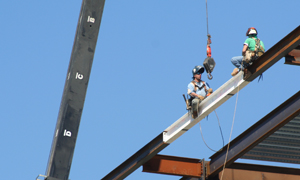It’s a Bird, It’s a Plane, It’s a Tree?
Commuters driving up and down South University may have thought they were seeing things. Was that a pretty substantial pine tree sitting on the top of the superstructure of UALR’s new nanotechnology building under construction on the west side of campus?
It was. Why? It’s an old construction tradition that when the last beam of a building’s superstructure is riveted in, a topping out ceremony follows, and a pine tree is placed on the top beam.
Sometimes, the last beam is painted white, and the builders sign their names on it. That’s what construction workers, students, faculty, and other stakeholders did at the EIT “sign the beam” ceremony in 2009.
No one seems to know for sure where the tradition started, but topping out ceremonies were common in the United Kingdom, Germany, Poland, and the Czech Republic, and the tradition emigrated to America with European tradesmen.
The topping out of the nanotechnology building dusted off a few memories for Mike Tramel, chair of UALR’s Construction Management program. Tramel has been to many a topping out party when he helped build mines, power plants, and other big industrial projects out West as a union ironworker in his youth.
“They didn’t have many pine trees out there, so we painted tumbleweed green and tied it to an American flag and topped out with that. Of course, this was before OSHA,” he said. And he said the parties were pretty rowdy. “They’d fill a pickup truck filled with beer and back it into the site.”
Tramel said ironworkers had several building traditions, including raising a black ribbon it the top of the structure in honor of a worker who died on the job.
“These days, topping out ceremonies are mostly done for public relations, especially for commercial buildings,” he said.
Anthropologists say the earliest references of topping out date from around 700 A.D., when Scandinavians topped off construction of new halls with sheathes of grain for Odin’s horse to assure good luck to future occupants of the building.
The Norman Invasion brought the tradition to Great Britain. Germans substituted small trees for sheathes of grain, and German tribes used only evergreens. It is thought that the tradition reached America via immigrant Norwegian ironworkers.
Americans added their own twist to the ceremony, hoisting an American flag beside the tree.
Looks like the tree atop the nanotechnology structure was removed for more construction work. But keep an eye out for the next topping out tree. It’s a salute to a thousand-year tradition.
Follow the progress of the nanotechnology building construction, and see renderings of this and other campus building projects on our construction website.



